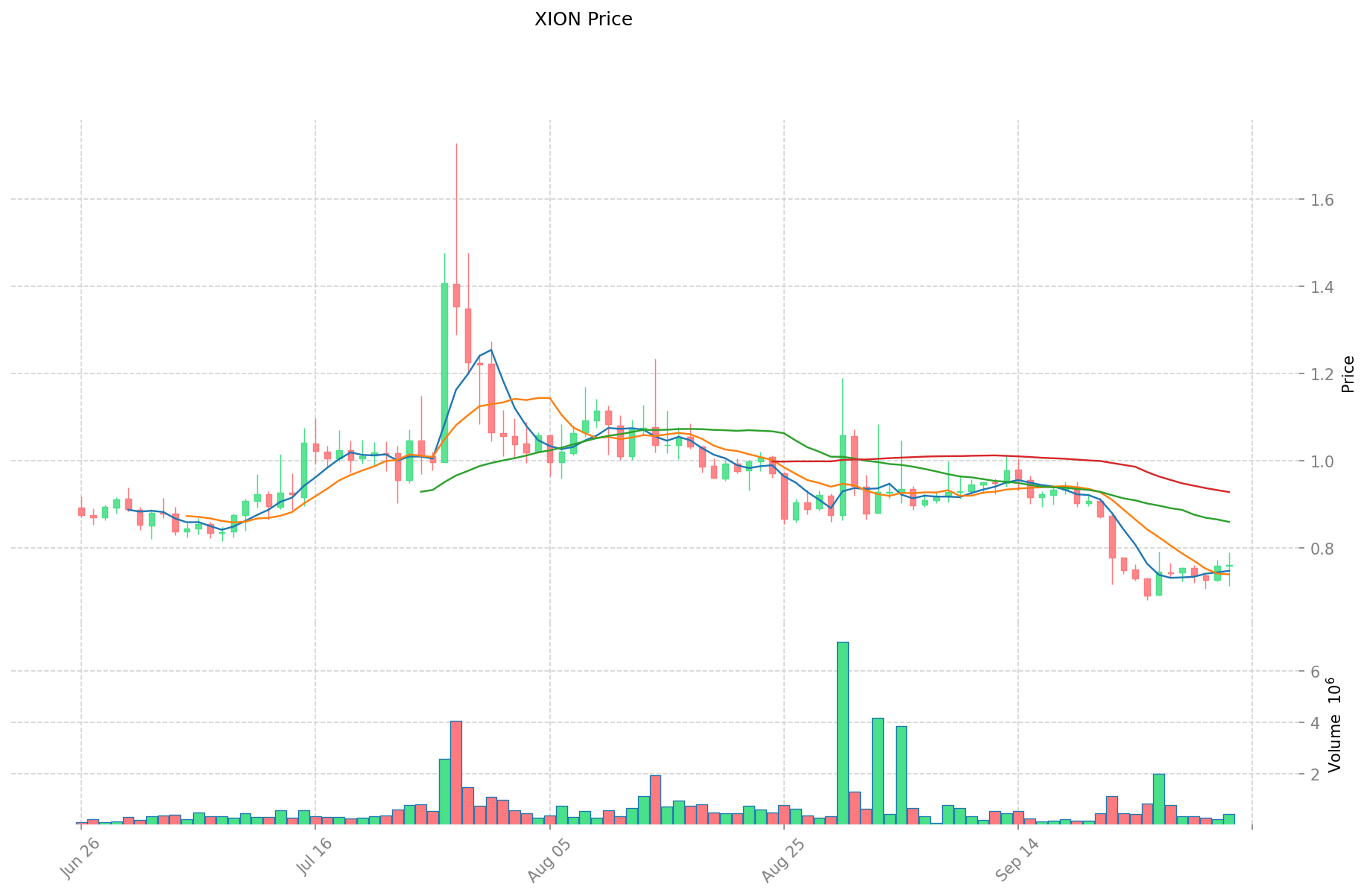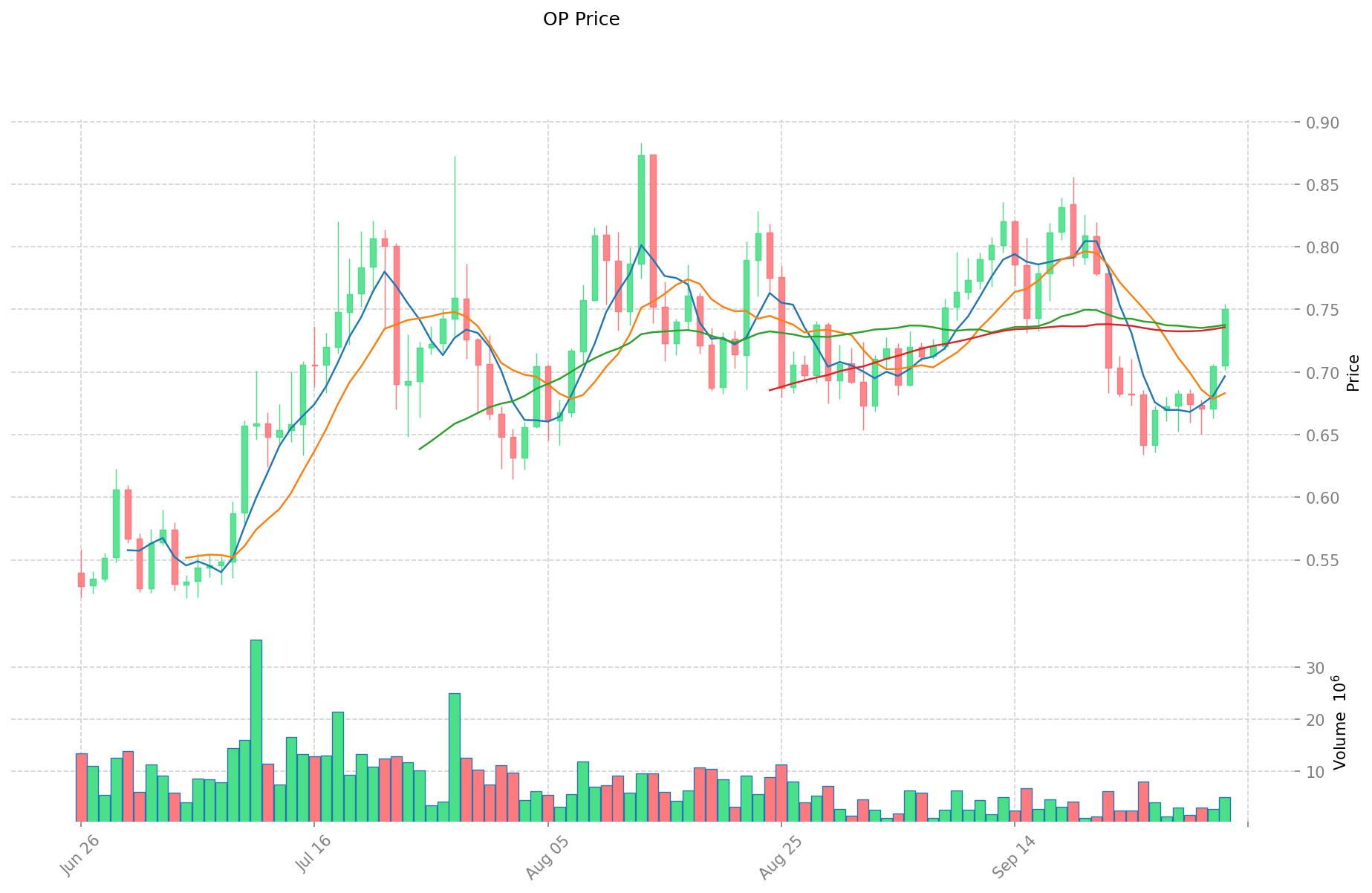XION vs OP: Comparing Layer 2 Solutions for Ethereum Scalability and Performance
Introduction: Investment Comparison of XION vs OP
In the cryptocurrency market, the comparison between XION and OP has been an unavoidable topic for investors. The two not only show significant differences in market cap ranking, application scenarios, and price performance but also represent different positioning in the crypto asset landscape. XION (XION): Since its launch, it has gained market recognition for being the first walletless L1 built for mainstream adoption through chain abstraction. Optimism (OP): Since its inception, it has been hailed as a low-cost, lightning-fast Ethereum Layer 2 solution, addressing the practical needs of developers and users. This article will comprehensively analyze the investment value comparison between XION and OP, focusing on historical price trends, supply mechanisms, institutional adoption, technical ecosystems, and future predictions, attempting to answer the question most concerning to investors:
"Which is the better buy right now?"
I. Price History Comparison and Current Market Status
XION (Coin A) and OP (Coin B) Historical Price Trends
- 2024: XION reached its all-time high of $11.9999 on November 14, 2024.
- 2024: OP hit its all-time high of $4.84 on March 6, 2024.
- Comparative Analysis: In the recent market cycle, XION dropped from its high of $11.9999 to a low of $0.5, while OP declined from $4.84 to its current price level.
Current Market Situation (2025-10-03)
- XION current price: $0.7365
- OP current price: $0.7295
- 24-hour trading volume: XION $204,831.17 vs OP $3,323,459.37
- Market Sentiment Index (Fear & Greed Index): 64 (Greed)
Click to view real-time prices:
- Check XION current price Market Price
- Check OP current price Market Price


II. Key Factors Affecting XION vs OP Investment Value
Supply Mechanism Comparison (Tokenomics)
- XION: Designed with chain abstraction for user experience, using USDC for stable pricing system
- OP: No specific information provided in the reference materials
Institutional Adoption and Market Applications
- Institutional Holdings: No specific information provided in the reference materials
- Enterprise Adoption: XION focuses on consumer adoption through chain abstraction protocols
- Regulatory Attitudes: No specific information provided in the reference materials
Technology Development and Ecosystem Building
- XION Technology: Features integrated protocol layer functionalities including account management, signature processing, and fee handling
- OP Technology: No specific information provided in the reference materials
- Ecosystem Comparison: XION maintains core Web3 features (decentralization, transparency, verifiability) while delivering frictionless user experiences; integrates with applications like Dave that handle complex interactions seamlessly
Macroeconomic and Market Cycles
- Inflation Performance: XION uses USDC at the network level to provide familiar fiat-based value and pricing systems
- Monetary Policy Impact: No specific information provided in the reference materials
- Geopolitical Factors: No specific information provided in the reference materials III. 2025-2030 Price Prediction: XION vs OP
Short-term Prediction (2025)
- XION: Conservative $0.69-$0.74 | Optimistic $0.74-$0.83
- OP: Conservative $0.66-$0.73 | Optimistic $0.73-$0.93
Mid-term Prediction (2027)
- XION may enter a growth phase, with prices estimated at $0.68-$1.01
- OP may enter a growth phase, with prices estimated at $0.72-$1.04
- Key drivers: Institutional capital inflow, ETF, ecosystem development
Long-term Prediction (2030)
- XION: Base scenario $0.94-$1.12 | Optimistic scenario $1.12-$1.57
- OP: Base scenario $0.75-$1.35 | Optimistic scenario $1.35-$1.79
Disclaimer
XION:
| 年份 | 预测最高价 | 预测平均价格 | 预测最低价 | 涨跌幅 |
|---|---|---|---|---|
| 2025 | 0.834731 | 0.7387 | 0.694378 | 0 |
| 2026 | 1.140737475 | 0.7867155 | 0.6293724 | 7 |
| 2027 | 1.011912811875 | 0.9637264875 | 0.684245806125 | 31 |
| 2028 | 1.056967025165625 | 0.9878196496875 | 0.711230147775 | 34 |
| 2029 | 1.226872004911875 | 1.022393337426562 | 0.695227469450062 | 39 |
| 2030 | 1.574485739636906 | 1.124632671169218 | 0.944691443782143 | 53 |
OP:
| 年份 | 预测最高价 | 预测平均价格 | 预测最低价 | 涨跌幅 |
|---|---|---|---|---|
| 2025 | 0.934144 | 0.7298 | 0.664118 | 0 |
| 2026 | 1.11484248 | 0.831972 | 0.72381564 | 14 |
| 2027 | 1.0415457468 | 0.97340724 | 0.7203213576 | 33 |
| 2028 | 1.15859796741 | 1.0074764934 | 0.95710266873 | 38 |
| 2029 | 1.61372547330345 | 1.083037230405 | 0.66065271054705 | 48 |
| 2030 | 1.793347197966119 | 1.348381351854225 | 0.755093557038366 | 84 |
IV. Investment Strategy Comparison: XION vs OP
Long-term vs Short-term Investment Strategies
- XION: Suitable for investors focused on mainstream adoption and user experience
- OP: Suitable for investors interested in Ethereum Layer 2 solutions
Risk Management and Asset Allocation
- Conservative investors: XION: 40% vs OP: 60%
- Aggressive investors: XION: 60% vs OP: 40%
- Hedging tools: Stablecoin allocation, options, cross-currency portfolios
V. Potential Risk Comparison
Market Risk
- XION: Volatility due to newer project status
- OP: Dependence on Ethereum ecosystem performance
Technical Risk
- XION: Scalability, network stability
- OP: Scalability, security vulnerabilities
Regulatory Risk
- Global regulatory policies may affect both differently, with potential impacts on Layer 1 and Layer 2 solutions
VI. Conclusion: Which Is the Better Buy?
📌 Investment Value Summary:
- XION advantages: First walletless L1, focus on mainstream adoption, chain abstraction
- OP advantages: Established Ethereum Layer 2 solution, low-cost and fast transactions
✅ Investment Advice:
- New investors: Consider a balanced approach, allocating to both for diversification
- Experienced investors: Evaluate based on risk tolerance and belief in respective technologies
- Institutional investors: Consider both for different aspects of blockchain ecosystem exposure
⚠️ Risk Warning: The cryptocurrency market is highly volatile. This article does not constitute investment advice. None
VII. FAQ
Q1: What are the main differences between XION and OP? A: XION is the first walletless L1 built for mainstream adoption through chain abstraction, while OP is a low-cost, lightning-fast Ethereum Layer 2 solution. XION focuses on consumer adoption and user experience, while OP addresses the needs of developers and users within the Ethereum ecosystem.
Q2: Which cryptocurrency has shown better price performance recently? A: Based on the provided information, XION reached a higher all-time high of $11.9999 in November 2024, compared to OP's all-time high of $4.84 in March 2024. However, both have experienced significant drops since their peaks, with XION currently trading at $0.7365 and OP at $0.7295 as of October 3, 2025.
Q3: What are the key technological features of XION? A: XION features integrated protocol layer functionalities including account management, signature processing, and fee handling. It maintains core Web3 features (decentralization, transparency, verifiability) while delivering frictionless user experiences. XION also uses USDC at the network level to provide familiar fiat-based value and pricing systems.
Q4: How do the long-term price predictions for XION and OP compare? A: For 2030, XION's base scenario predicts a price range of $0.94-$1.12, with an optimistic scenario of $1.12-$1.57. OP's base scenario for 2030 predicts a price range of $0.75-$1.35, with an optimistic scenario of $1.35-$1.79. Both show potential for growth, with OP having a slightly higher optimistic prediction.
Q5: What are the recommended investment strategies for XION and OP? A: For conservative investors, a suggested allocation is 40% XION and 60% OP. For aggressive investors, the recommendation is 60% XION and 40% OP. New investors might consider a balanced approach, allocating to both for diversification, while experienced investors should evaluate based on their risk tolerance and belief in the respective technologies.
Q6: What are the potential risks associated with investing in XION and OP? A: For XION, risks include volatility due to its status as a newer project, as well as potential scalability and network stability issues. OP faces risks related to its dependence on the Ethereum ecosystem performance and potential security vulnerabilities. Both cryptocurrencies may be affected by global regulatory policies, which could impact Layer 1 and Layer 2 solutions differently.
Share
Content